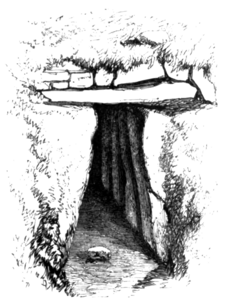shire churches; but it is worthy of remark that in Ireland the churches are not generally vaulted, while the houses are. In those early examples, such as St. Kevin's in Glendalough and St. Columbkill's at Kells, the vault is at a considerable elevation from the ground, and had wooden floors under it, as in the castles or towers of the twelfth century and later.
The peculiar form of doorway with sloping sides and a flat lintel, which is quite an Irish fashion, seems also to have originated in the nature of the material. A similar form of doorway occurs in the Egyptian Pyramids, and in some other oriental buildings, and this may by some persons be considered as an evidence of the oriental origin of the Irish people; but that is not to our present purpose. In Ireland it is found in the cairns, as at New Grange, and in the Hill of Dowth, and is there formed simply of three long stones, not cut, but selected for the purpose, and the top inclined inwards in order to fit the lintel-stone more conveniently, and give it a longer bearing on the side stones. This is the case also at St. Kevin's house in Glendalough, which is of Cyclopean masonry. The same form was copied afterwards in cut stone, as in the round towers at Kells and Clondalkin; and it became a regular Irish fashion, continued both in doorways and windows when convenient at all periods down to the time of Elizabeth. It occurs in the tower-houses throughout the Middle Ages, and in Elizabethan work of dated houses at Galway.
The triangular-headed window is another feature which evidently has its origin in the material, and, although found in early work, is not confined to any period;


